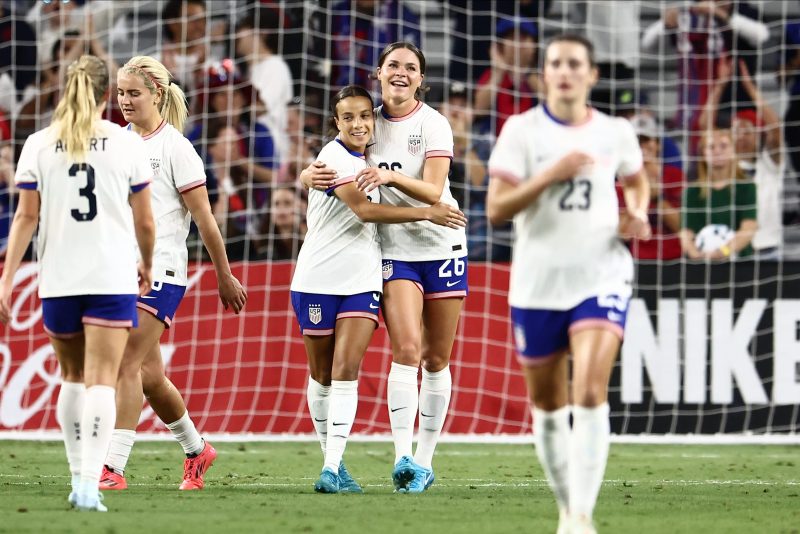The U.S. women’s national team once again defeated Iceland 3-1, but the path to that result on Sunday in Nashville was much different than Thursday’s victory.
While this match functioned as a celebration of captain-for-the-day Mallory Swanson’s 100th cap (a milestone she surpassed at the Olympic gold medal match), the star of the day may well have been someone collecting their first.
Emma Sears, the Racing Louisville rookie, marked her USWNT debut in style, setting up Lynn Williams for a 72nd-minute equalizer and powering home the game’s final goal in stoppage time. Williams joined Sears with a one goal/one assist line on the day after setting Lindsey Horan up for the eventual match-winner as the U.S. struck three times in the final 18 minutes.
A well-drilled Iceland side took the lead at Geodis Park — the first opposing team to do so since Emma Hayes took charge — and got to the hour mark having conceded relatively few good looks while offering more than simply a parked bus for the USWNT to solve. Unlike Thursday’s meeting, where the U.S. always seemed on course to claim a win and simply had to wait for some late goals, the chances weren’t necessarily there in Tennessee.
Hayes wanted a test, and the 13th-ranked team in the world certainly provided it. Here are the three main takeaways from this second victory over Iceland:
Growing pressure in goal?
The USWNT had more of the game’s early attacking moves, but an unusual moment would see the team trail under Hayes for the first time.
A 31st-minute Karólína Lea Vilhjálmsdóttir corner ended up going straight in at the back post, evading both goalkeeper Casey Murphy’s attempt to catch it and a last-second lunge from Emily Sams to save the ball on the line.
Take nothing from Vilhjálmsdóttir, who put the ball into a very dangerous place and reaped the rewards, but it’s not exactly the finest hour for Murphy. The early-evening sun in Nashville had set enough that this wasn’t a glare issue, nor did Iceland put a body on the North Carolina Courage No. 1 to distract her from the flight of the ball. Murphy misread the ball’s trajectory as a cross, overcommitting with a big step that left her unable to recover.
Generally speaking, Murphy has played her very best soccer as a pro with the USWNT, where she consistently exceeded some uneven performances in 2022 and 2023 with the Courage. This mistake, in her second appearance since Hayes’ arrival, is not the best way to ensure more of a place in the mix.
While Alyssa Naeher’s grasp on the starting job seems very strong, coaching changes generally come with an examination of the depth chart at all spots. Murphy’s competition may have been reduced in this camp after Jane Campbell was released due to a knock, with her replacement in camp Mandy Haught not in uniform. Haught is in camp for good reason, having gotten onto the radar with consistently good performances with NJ/NY Gotham FC in 2023, and this year in a tougher situation with the Utah Royals.
Haught currently leads all NWSL goalkeepers in American Soccer Analysis’ Goals Added metric (a measure of overall contributions to team success) and in post-shot expected goals minus goals allowed (PSxG+/-), which essentially measures a goalkeeper’s shot-stopping and/or luck. Both are not perfect measures, but being top of the table in both categories indicates a player who is in better NWSL form than Murphy (who is sixth in the league in both categories).
This may be the biggest error of Murphy’s USWNT career up to this point, and one she probably won’t repeat. However, with younger players providing compelling competition (not to mention Campbell, Aubrey Kingsbury, and other options in the USWNT pool), it’s a moment that may have invited more scrutiny from the coaching staff.
Plan A won’t be Hayes’ only plan
The USWNT had not trailed under Hayes until Sunday, which meant few looks at what this team would do when it’s time to really push for an equalizer.
While halftime’s triple sub didn’t come with a system change, Mallory Swanson took up a role as a No. 10, something she had begun doing in stretches of the first half (with Olivia Moultrie moving wide, particularly out of possession). The real shift came in the 66th minute, when Sophia Smith replaced Casey Krueger.
Out went a 4-3-3 that would shift into a 4-4-2 without the ball, and in came a hyper-aggressive 3-5-2. This is how the USWNT set up for the game’s final 24-plus minutes:
Are Sears and forward Alyssa Thompson going to spend a lot of time working as wingbacks going forward? No. But it did make for a steamroller of a lineup, with legit track-runner speed on both flanks pushing up high. Hayes took a big chance on an all-Emily back three, with Sams and Emily Fox having to spread wide and cover lots of ground while Emily Sonnett was left isolated against one of Europe’s best young strikers, Sveindís Jónsdóttir.
However, the gamble paid off, as Iceland’s relative comfort level disappeared in the face of a wave of white shirts. With the wingbacks really functioning as wingers — you could argue this set-up was 3-3-4 at times — and both Swanson and Lindsey Horan expertly upping the USWNT’s tempo in possession, Iceland struggled to disrupt the game. When the U.S. lost possession, Iceland was suddenly unable to find the exit, leaving the final 15 minutes of the match feeling like an offense vs. defense drill.
Once Lynn Williams bagged the equalizer, only one team was ever going to claim a win here.
Does the USWNT need to look at this formation as a full-time solution? Probably not. From the start of a match, less tired foes will find the exit in possession, and that means more potential one-on-ones on the counter than Iceland could provide. The U.S. doesn’t have to roll the dice to this extent to beat most opponents.
But games aren’t just won and lost by Plan A, and Hayes knows that as well as any coach on the planet. The language shift from ‘substitutes’ to ‘game-changers’ isn’t her original innovation, but it feels like it means more now than it has in the past. The USWNT isn’t just going to try Plan A with different players, or with more energy; Hayes will change the formation with purpose, particularly if it gets this many weapons on the field at once.
‘I’ve got to say for today, learning to come from behind, having the belief to do that, and having the depth to do that,’ were positives cited by Hayes in her post-match press conference. ‘When you play against top teams, you might have 60 minutes where it’s really, really cagey, but when you go to your bench, you bring players in, you want to be able to take that up a notch.’
One notch might not fully underline just how drastic the formation change and the performance level jump was in Nashville. It’s not going to happen every time, but it’s important to show that this team has solutions that opponents might not be able to predict.
Sears announces herself as USWNT option
If you could add one thing to the USWNT pool to address a team need, another wide forward might be low on your list of priorities. The logic is simple: the U.S. has so many excellent players in those positions that you can probably use this hypothetical gift on some other area.
However, this country keeps producing players who are ready to threaten goal from wide left or wide right at an elite level, and Louisville winger Sears is the latest player to show up as an option. The NWSL rookie got a clever assist on Williams’ equalizer, and then was clinical in making sure this match ended with an exclamation point in stoppage time.
‘I think it’s honestly hard to find the words right now,’ Sears told TNT after the match. ‘It’s super surreal, not only being surrounded by such amazing people, but also players I’ve looked up to for so many years.’
In her 35-minute debut, Sears put up one goal and one assist, misplaced just one pass attempt, got back to provide a clearance, and used the mere threat of her speed to force Iceland’s left-sided players to make purely defensive, reactive decisions. As surreal as she feels her debut was, there’s also something extremely unusual about how this team just keeps adding wide players capable of this kind of impact.
‘I think Emma Sears was direct in what she was doing,’ Hayes told reporters after the win. ‘What I liked about [Sears] was [her] intention. She’d turn, she’d face up, she’d go forward, play forward. Her first touch on the ball, she got us into the corner and got something out of it. I liked her intention, her positivity.’
No one’s about to break up the Triple Espresso front line, though it is notable that Hayes has shifted a longtime USWNT winger (Williams) into more or less a full-time No. 9 role. But the veteran starts wide with Gotham, and Jaedyn Shaw isn’t always going to end up as a center forward (as she did on Sunday) or as a No. 10. Thompson has shown in the back half of this season that she’s very much in the mix, Rose Lavelle could be moved up to play as a forward of sorts, and Ashley Sanchez could as well.
But amid all of that, Sears offers something that this group only gets from Trinity Rodman: a player most effective out on the touchline, running at defenders in isolation. Both can torch markers in space, both have moves to beat a defender on the dribble, and both are a physical mismatch if you try to body up.
On a team that will face deep-lying teams on a regular basis, there is often talk about players who can find pockets and use their close control to pick the lock, so to speak. For those players to thrive, you need to stretch teams elsewhere (vertically or across the width of the field), and that’s the kind of role Sears is built for. Don’t be surprised if she’s used this camp to earn herself more looks going forward.

